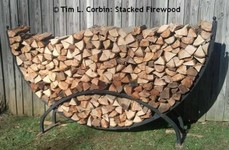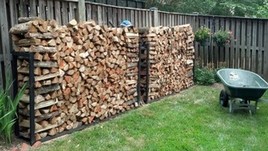Firewood FAQs
Firewood Sales
Learn All About Firewood at this Site: www.firewood-for-life.com
Using Firewood to Heat Your Home.
Recomendations for Storage:
We do not recommend stacking wood next to your house or inside your house because of insects. We also recommend some kind of rack to keep wood off the ground and a tarp to keep it dry. Safe firewood practice as well as fall leaf litter reminds us that no combustible materials should be up next to or resting on the sides of our homes. A safe distance for firewood storage
is at least 5 or 8 feet away from a residence or garage.
What is a CORD?
The cord is a unit of measure of dry volume used in Canada and the United States to measure firewood and pulpwood. A cord is the amount of wood that, when “ranked and well stowed” (arranged so pieces are aligned, parallel, touching and compact), occupies a volume of 128 cubic feet (3.62 m3).[1] This corresponds to a well stacked woodpile 4 feet (122 cm) high, 8 feet (244 cm) long, and 4 feet (122 cm) deep;
or any other arrangement of linear measurements that yields the same volume.



Question: What wood species gives off the most heat?
You will get the best results and more heat per wood volume when burning the highest density (heaviest) wood you can find.
Dense firewood will produce the highest recoverable BTUs but all wood must be "seasoned" for best results.
Seasoning lowers the moisture content and less energy is used to drive off water which limits heat efficiency.
Many of these heavy woods have excellent burning properties during the three stages wood goes through
when burned. The final "coaling" stage is very important for sustaining heat over time.
All of the best, and usually hardest and heaviest, wood species have excellent coaling properties
as they continue burning after initial moisture and all gasses are driven off.
Answer: Seasoned wood with significant density will increase heat production.
Trees considered to be deciduous (lose their leaves in winter) and more specifically hard hardwoods
tend to be a more dense wood and will burn hotter and longer than trees considered to be evergreen
or softwood (there are some exceptions). Firewood also tends to burn hotter when seasoned under a shelter
to reduce the moisture that drives off heating as wood burns. Wood heat value is measured in
BTUs or British Thermal Units. The higher the BTU value, the more heat you get per unit of wood.
I have developed a chart of the most common species and their
heating value based on density, weight, BTUs and coaling ability.
Here is a list of the best and worst tree species ranked by their total ability to establish and retain heat:
Five Best Burning Tree Species:
•Hickory - 25 to 28 million BTUs/cord - density 37 to 58 lbs./cu.ft.;
•Oak - 24 to 28 million BTUs/cord - density 37 to 58 lbs./cu.ft.;
•Black Locust - 27 million BTUs/cord - density 43 lbs./cu.ft.;
•Beech - 24 to 27 million BTUs/cord - density 32 to 56 lbs./cu.ft.;
•White Ash - 24 million BTUs/cord - density 43 lbs./cu.ft.
Five Poor Performing Tree Species:
•White Pine - 15 million BTUs/cord - density 22 to 31 lbs./cu.ft.;
•Cottonwood/Willow - 16 million BTUs/cord - density 24 to 37 lbs./cu.ft.;
• Basswood - 14 million BTUs/cord - density 20 to 37 lbs./cu.ft.;
•Aspen - 15 million BTUs/cord - density 26 lbs./cu.ft.
However, small pieces of dry Pine make good fire starters.



